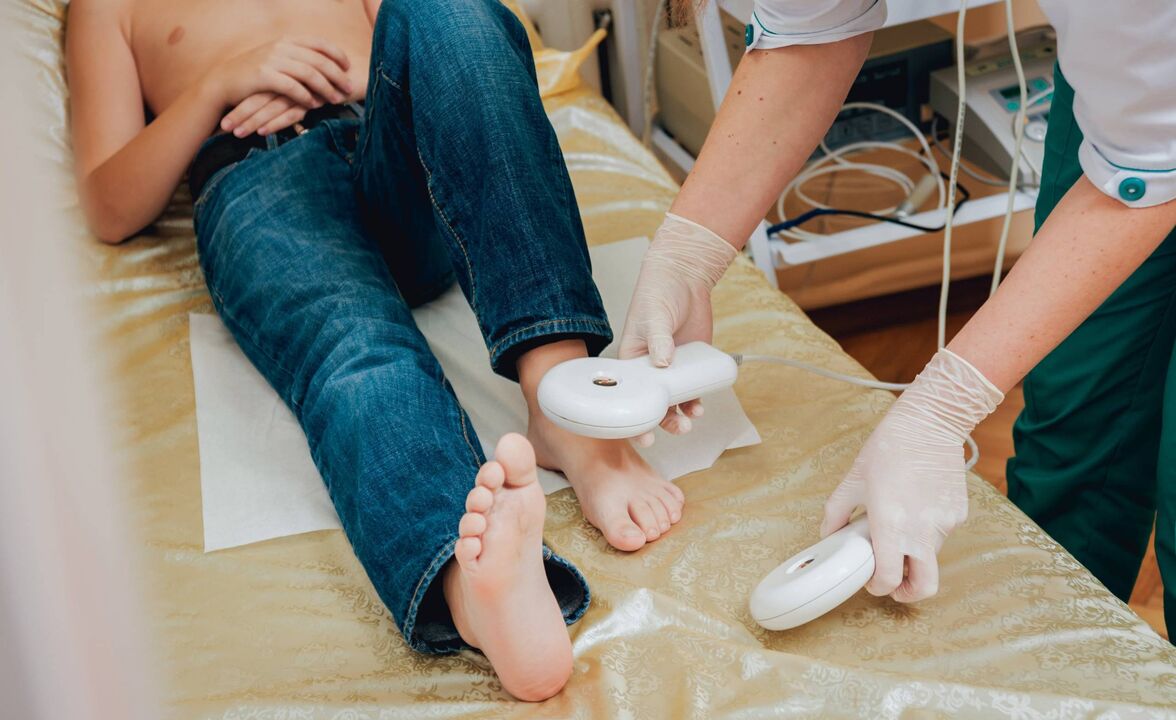Nail fungus - an infectious disease that affects the nail plate. In a severe form of the current, it goes to the skin roller and can spread to other areas. Activation of pathogenic microorganism is possible when visiting public places, while wearing tight shoes, with weakened immunity, injuries.
About the onset of the development of the disease, a change in the color of the affected area, extension of the nail, brittleness, soreness, peeling and an unpleasant odor indicate a change in the color of the affected area. Diagnosis includes bacteric particles from the affected area, histology, cultural examination, blood test. Medication treatment. In some cases, surgical intervention is required.
Contrary to the opinion that the shoes of a person whose nails are affected by a fungal infection should be thrown away, this is not so.
It must be treated with a special apparatus, which, when placed inside, emits ultraviolet radiation and kills mushrooms.
It is also allowed to use a 40-%solution of vinegar diluted in water. The shoes are wiped from the inside with the resulting composition and placed in a sealed bag for several hours.
What is nail fungus
Despite the fact that onychomycosis (a fungal infection of the nail) is not a danger to life-this is an important problem of public healthcare due to high prevalence and therapeutic difficulties associated with high indicators of relapse and the progression of chronic lesions. It has certain consequences for patients, such as discomfort and painful reactions.
Dermatophytes are usually responsible for onchomycosis in countries with a temperate climate. Destroying keratin and absorbing its nutrients, they represent hyaline septic forms. The gifs of these mycelial organisms penetrate into the stingy layer of the skin and nails.
Fungk cells produce keratinolytic proteases that provide a way to pass into living cells. Some species are mainly soil saprophytes that acquired the ability to digest keratinized particles and evolved so that they were able to parasitize the keratin tissues of animals.
The term "dermatophytosis" is used to describe the infection by members of the microsporum, trichophyte and epidermophyte. Types that most often cause onychomycosis - red trichophyte, trichophyte mentagrofitest and flap -shaped epidermophyte (pathogen of epidermophytosis): the first two are much more often participated as causal factors.
Only one red trichophyte is responsible for more than 80% of onychomycosis. Skin, hair, nail infection with incomplete forms (wanderer and scopulariopsis) are called "dermatomycosis. "Both dermatophytes and incidents are identified as the only etiological agents of onychomycosis.
The infection begins with the discoloration and deformation of the nails, which causes pain and complicates their haircut. In patients with complicating factors, it leads to damage to surrounding tissues, can contribute to a secondary bacterial infection.
Moreover, recent studies have revealed the psychological, social and professional consequences of the condition, which seems to be underestimated by health care experts in the treatment of this condition.
Doctors note that nail fungus is a common problem that can affect people of all ages. The main symptoms include a change in the color of the nails, their thickening and brittleness. Experts emphasize that an important aspect of treatment is early diagnosis, since advanced cases may require a longer and more complicated treatment. Doctors are recommended to use both local and systemic antifungal drugs, depending on the degree of damage. In addition, they focus on the need to comply with hygiene norms and preventive measures, such as wearing convenient shoes and the use of individual legs care. It is also important to remember that the fungus can be transmitted from person to person, so common bathrooms and showers should be avoided.
How to treat nail fungus?
Statistics
Fungal damage to nails is subject to 5 to 15% of the population. With age, the prevalence of the pathological process increases to about 30% after reaching 65 years. However, it is worth noting that often the fungus occurs in children.
Approximately every 10 years, incidence rates increase 2. 5 times. At the same time, in childhood, it is only 3%, while among the adult population reaches up to 60%.
Unlike women, men are more affected by men. In addition, the pathological process 3-7 times more often affects the lower limbs than the upper ones.
All varieties of parasitic mushrooms are combined into 3 groups.

Scraping to skin fungus
The lesion of the fungus is one of the most common pathologies that belongs to skin diseases.
In 80% of patients, the disease develops against the background of the reproduction of dermatophytes.
Explosive parasites are 5 times more likely to be localized on the nails of the hands. Mold mushrooms are the rarest species.
In people with diabetes mellitus, the incidence rate is 3 times higher. In 90% of people with psoriasis, the probability of infection also increases by 2 times.
Reasons
Risk factor is contact with the source of infection. For example, Trichophyte Verrucosum, evolving from ancestors living in the soil, infects farmers, agricultural workers, veterinarians. It is transmitted through direct contact or bites, although cases of infection obtained in the laboratory were also registered.
Several factors unique to modern life led to the prevalence of onychomycosis. These include:
- Wearing tightshoesin high heels;
- Using commonwetpremises (as shower and locker rooms);
- Deterioration of healthagingpopulation;
- an increase in the number of people with weakenedimmunitydue to diseases (for example, HIV infection);
- Therapeuticagents (immunosuppressants, post -operation therapy, the use of wide spectrum antibiotics);
- straightinjurynails, including certain teak disorders (biting nails);
- Geneticpredisposition.

Treatment of nail fungus with a laser
Laser therapy of nail fungus is an effective hardware method that helps to accelerate recovery.
True fungal infections are found on the nails of the toes much more often than on the nails of the fingers. This is due to the fact that they are subject to greater friction and sweating. Socks and shoes contribute to a dark and humid fungal environment.
The causes may include poor peripheral blood circulation, diabetes, repeated nail injury, inability or unwillingness to correctly cut the nails on the legs and maintain proper care for them. Risk increases with age and through the underlying disease of the nails.
Many people are faced with the problem of nail fungus, and opinions about it are very diverse. Some argue that this is not only an aesthetic problem, but also a serious disease that requires an attentive approach. Many share their experience of treatment, talking about various drugs and folk remedies. Some note that the fungus can return even after successful treatment, which causes disappointment and fear of re -infection. Others emphasize the importance of prevention, advising to monitor hygiene and avoid public places with high humidity. In general, a discussion of nail fungus is often accompanied by tips and recommendations, which indicates its prevalence and relevance of the problem in society.
Nail fungus. Treatment of neglected shape of nail fungus
Types
The prevalence of nail fungus varies all over the world due to several cultural and socio-economic factors. Namely, it depends on the geographical reion, population, mycological features and diagnostic methods used.
Four types of onychomycosis, characterized by a clinical manifestation and an invasion route, have been identified.
Distal and lateral submarine onychomycosis
It is observed in most cases and is almost always due to a dermatophytic infection. It acts on hyponichia, often along the edges of the side sides, spreads proximally along the nail bed, which leads to sub -hepherdia and onchilolysis, although the nail plate is not initially affected.
It can be limited by one side and spread on the side, covering the entire nail and progressing steadily until it reaches the rear nail roller.
In the end, the nail plate becomes loose, can split, often due to injury, although destruction is most likely associated with invasion with dermatophytes that have keratolytic properties. Examination of the surrounding skin almost always reveals signs of dermatophytosis.
Superficial white onychomycosis
This is a dermatophytic infection caused by Trichophyton Mentagrofitest. A less common type affects the surface of the nail plate, which acquires a whitish color and noticeably exfoliates (but onycholysis is not a feature of onchiomycosis).
It happens that an erroneous diagnosis can be made when it is taken for "keratin granulations" (reaction to nail polish). To confirm, it is necessary to conduct a laboratory test.
Proximal tray onychomycosis
A rare form of dermatophytic infections, often associated with intercurrent disease. The pathogenic fungus invades the nail plate of eponichia and the matrix of the nail. It occurs in immunosuppressive patients.
Candidiasis onychomycosis
Another name is the infection of the nail with yeast Candida, classified by:
- chronicParonichiawith secondary dystrophy of nails;
- chroniccandidiasismucous membrane;
- Distalinfectionnails;
- secondarycandidiasis.

Nail fungus prevention
The fungus of nails and feet is an infectious disease caused by pathogenic bacteria.
Distal infection with yeast is rare (in patients with Raynaud's disease or another form of vascular failure).
Chronic paronichia occurs in raw conditions. Swelling of the rear fold of nails is secondary in relation to a chronic wet state. The cuticle, separating from the nail plate, loses waterproof properties. Microorganisms penetrate into the subcutaneous space, provoking the swelling of the posterior fold.
Chronic mucous-loop candidiasis covers the mucous membranes, which is caused by a decrease in cellular immunity. Clinical signs vary depending on the severity of immunosuppression, in severe cases there is a complete thickening of the nail.
Secondary candidal onychomycosis occurs due to a number of nail diseases, mainly psoriasis.
Total dystrophic onychomycosis is used to describe the disease of the nails in the last stage, although some clinicians consider it a separate subtype. It can be the final result of any of the four main models of onchomycosis.
Symptoms
The most common symptoms of the fungus are the extension of the nail and the change in its color in white, black, yellow or green. As the infection progresses from the initial stage to a neglected form, it becomes fragile, pieces are broken off from it. If you do not treat, then the skin under the nail and around is inflamed, hurt or peel off. There is an unpleasant odor.
Onychomycosis in patients with weakened immunity is a very serious health problem. Not only a severe infection serves as a constant reminder to the patient about his own worsened state, but there is the possibility of transferring fungal pathogens to another person.
Diagnostics
The clinical representation of deformed nails should warn the doctor about the possibility of onhomycosis. But since mushrooms are the cause of only half of all lesions, it is necessary to be careful in order to correctly identify the signs and symptoms of other diseases that simulate onychomycosis and differentiate different etiologies.
These include psoriasis, lichen, bacterial infections, contact dermatitis, traumatic Onichestrophy, congenital pachionichia, yellow nail syndrome, idiopathic onycholysis. Repeated nail injury can lead to distal oncholis - colonization of the damaged area with microorganisms that produce its pigmentation.
The use of appropriate diagnostic methods includes:
- smear,potassium treated with potassium hydroxide;
- selectionfungus cultures (from the selected material: curettage or fragment of the nail);
- histology.
The first step in the process of sampling is a thorough cleaning of the nail area from pollutants (bacteria) alcohol. Since the places of invasion and localization of infections differ in the types of onchomycosis, different approaches are practiced to obtain optimal samples depending on the alleged diagnosis.
Treatment
The main goal of treatment is to destroy the body demonstrated by microscopy and culture. Clinical improvement - secondary and based on a strict system for assessing the abnormalities of the nails.
It is important to admit that the successful destruction of the fungus does not always lead to the correct shape of the nails, since they can be deformed to infection.
The main methods of treatment are relevant or oral antifungal drugs:
- VarnishesThey consist of a fungicically effective amount of an antifungal agent in a transparent, stable, film -forming medium. When applying to the nails, the composition provides a solid, transparent, waterproof film.
- OralPreparations that fall directly into the bloodstream and, moving through the liver, enhance the likelihood of solving the problem. However, they have side effects, can cause negative reactions in combination with other drugs.
The main task is how to determine mycosis and provide relevant treatment. At this stage, some relevant drugs are only under development and testing. Those that are available in the pharmaceutical market are not able to provide a complete guarantee in cure.
To overcome the restrictions of traditional compositions, an effective system is necessary that can deliver antifungal agents deep into the nail.
For example, chemical (keratolytic) processing of the affected area, which, apparently, improves the results. Keratolytic agents, such as papain, urea and salicylic acid, are used to enhance the penetration of antifungal drugs.
Prevention
Everyone is closest to see his nails and can quickly recognize any changes. Even with a fungal infection, compliance with preventive measures is recommended strongly. After daily washing, the legs are thoroughly wiped, especially drying between the fingers.
It is preferable to wear cotton socks, use good powder or legs spray. Nails should be kept neatly trimmed. Both manicure and pedicure can be useful and sometimes allows you to really get rid of organisms (at the initial stage of infection).
In the last decade, significant successes have occurred in the development of effective and safe drugs, but the nail fungus will probably remain a disease of modern civilization, which is difficult to get rid of. Environmental conditions that contribute to this are associated with the life expectancy and an increasing number of people with weakened immunity.
Perhaps the most important task today is the exact diagnosis of a causal agent, which allows the choice of an optimal antifungal drug, the activity spectrum of which covers infecting microorganism.
Question-answer
What is the most effective remedy for the fungus on the nails?
The active substance of naphthyfin hydrochloride quickly penetrates the lesion, destroys pathogenic microorganisms at the cellular level. The solution and nail polish contains amorolphin hydrochloride.
How to remove the fungus on the nails at home?
One-twice a week, it is recommended to make baths for the legs in warm (37-38 degrees Celsius) water with the addition of sea salt (100 g) or a pinch of citric acid (50 g per 5 liters of water). Since the fungus is afraid of the acidic environment, such therapy helps to reduce the amount of fungal cells on the skin of the legs and on the nails.
What is the fungus on the nails afraid?
What is the fungus on the nails afraid? Onychomycosis does not like exposure to baking salt, hydrochloric solutions, hydrogen peroxide, temperature exposure above 60 degrees.
Is it possible to cure nail fungus vinegar and soda?
Often, with nail fungus, solutions of vinegar, soda, iodine, celandine or herbal infusions are used. However, these funds can solve only a superficial problem. If the fungus has already entered the nail bed and matrix, folk methods will be useless. On the contrary, they often provoke inflammation, irritating soft tissues.
Adviсe
Council No. 1
Spend the condition of the nails regularly. Pay attention to changes in the color, texture and shape of the nails. Early detection of the fungus will help to avoid its spread and facilitate treatment.
Council No. 2
Mront your legs in dryness. The fungus prefers a wet environment, so try to wear breathing shoes and change socks as often as possible, especially after physical activity or in hot weather.
Council No. 3
Avoid public places with high humidity, such as saunas, pools and locker rooms. If you still need to go there, use special protective shoes or slippers to minimize the risk of infection.
Council No. 4
Contact the doctor at the first signs of the fungus. Do not self -medicate, since improper treatment can aggravate the problem. A specialist will be able to prescribe effective drugs and give recommendations for nail care.
















